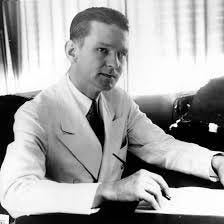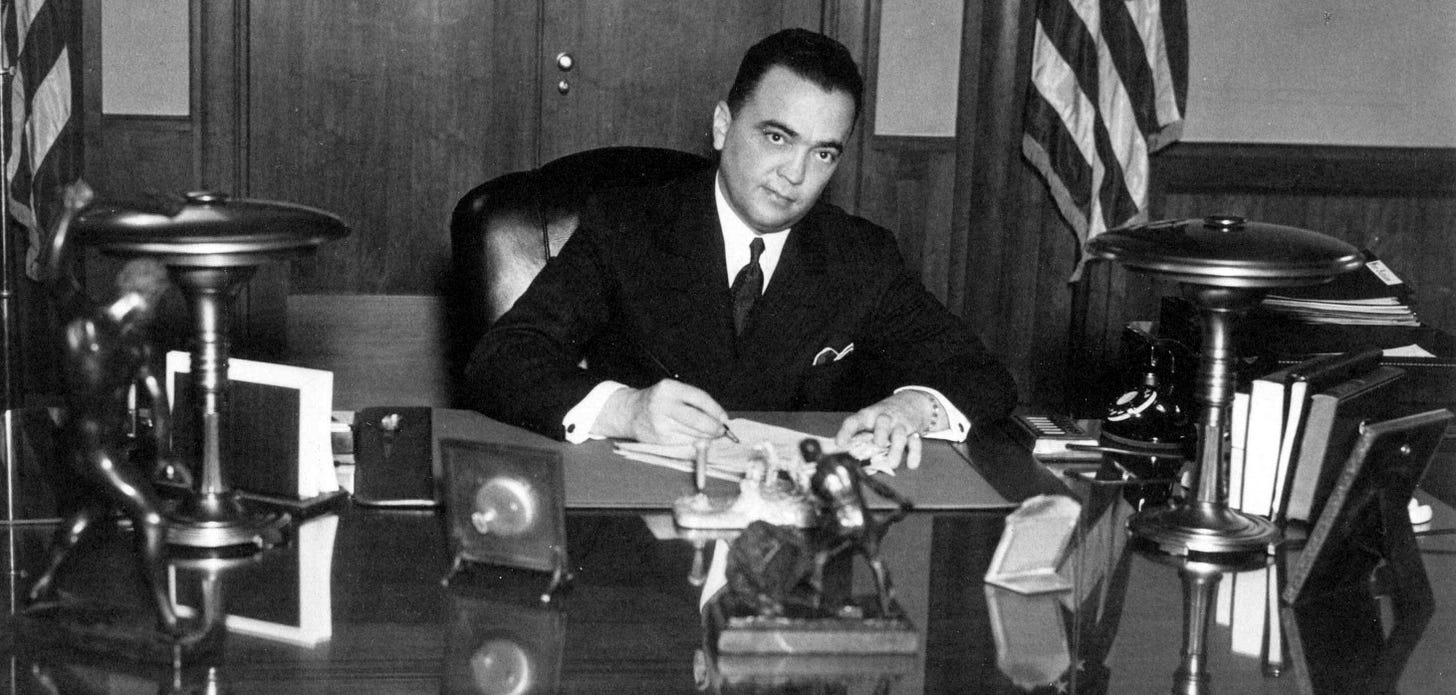Melvin Purvis: The Hero J. Edgar Hoover Tried to Erase
He was the celebrated agent who took down John Dillinger and became a national icon. But his fame earned him a single, powerful enemy: his boss, J. Edgar Hoover.
On July 22, 1934, Special Agent in Charge Melvin Purvis accomplished the impossible. He led the federal team that tracked down and killed John Dillinger outside Chicago’s Biograph Theater. It was a monumental victory in the nation’s “War on Crime,” a moment that should have cemented his future as a law enforcement legend.
Instead, it was a professional death sentence.
The problem wasn’t a gangster with a grudge, but a boss with an ego. Purvis’s spectacular success made him an overnight celebrity, known as the “Man Who Got Dillinger.” And in the world of FBI Director J. Edgar Hoover - a man obsessed with controlling the Bureau’s public image - there was simply no room for a subordinate to become the hero of the story. Hoover didn’t see a victory for the Bureau; he saw a rival for the spotlight.
What followed was one of the most vindictive, behind-the-scenes campaigns in FBI history. The man who had taken down America’s Public Enemy Number One would now face a relentless, systematic effort by his own director to tear him down, erase him from the narrative, and destroy the career he had built.

The Southern Gentleman Finds a Calling
America’s most famous G-Man wasn’t forged on the tough streets of a big city. Melvin Horace Purvis II was born in 1903 in Timmonsville, South Carolina, a world of tobacco farms and quiet Southern gentry. His father was a successful farmer, and the script for his life seemed pre-written: a law degree from the University of South Carolina, a respectable career, and a future of predictable comfort.
And it was life he rejected.
A quiet career in law, or even the diplomatic service, wasn’t enough. A restless streak pushed him toward something with higher stakes. In 1927, that push landed him in the Bureau of Investigation, a choice made explicitly for the promise of adventure. His timing was impeccable. He walked directly into J. Edgar Hoover’s grand experiment to forge a new kind of federal agency, just as Hoover was conducting a top-to-bottom purge of the Bureau’s old guard and needed a new kind of man to be its public face. The criteria were rigid: educated, professional, and utterly loyal. Melvin Purvis was the blueprint. At five-foot-four, he may not have been physically imposing, but his pristine resume made him the perfect raw material for the Director’s new public relations machine.

The Rise of the "Ace G-Man"
For a while, Hoover’s investment in his protégé paid off spectacularly. Purvis rose through the ranks with remarkable speed, becoming the Special Agent in Charge of the Cincinnati office at just 27 years old - the youngest field chief in the Bureau’s history. By October 1932, Hoover handed him the keys to the kingdom: the high-profile Chicago office, the epicenter of the nation’s blood “War on Crime.”
His tenure there wasn’t without its disasters. In April 1934, Purvis led a raid on the Dillinger gang’s hideout at the Little Bohemia Lodge in Wisconsin. It was a complete fiasco. Agents ended up shooting at innocent civilians, and by the time the smoke cleared, an agent and a civilian were dead, while Dillenger and his crew had slipped out the back. Humiliated, Purvis offered his resignation. Hoover, likely realizing that firing his star agent after a public failure would be a PR nightmare, refused to accept it. Instead, he sent a trusted senior agent, Samuel Cowley, to “oversee” the Dillinger hunt - a move that allowed Hoover to later minimize Purvis’s role in what was to come.
It was the setup for the greatest comeback in FBI history. Three months later, on July 22, 1934, it was Purvis who stood outside the Biograph Theater and gave the signal that ended John Dillinger’s reign of terror. The kill was a massive, desperately needed victory for the Bureau, and it made Melvin Purvis a household name overnight. As if that wasn’t enough, he followed it up that October by leading the team that tracked down and killed Charles “Pretty Boy” Floyd.
Two of the nation’s biggest outlaws were taken down in ninety days. The press went wild. Purvis was no longer just an agent; he was the “Ace G-Man,” the modest, soft-spoken hero who was winning the war on crime. And that is precisely when his career began to die. His fame now rivaled, and perhaps even eclipsed, his boss’s. The final insult came in December 1934, when a Literary Digest poll named Purvis one of the ten most outstanding personalities in the world. For J. Edgar Hoover, a man who believed the FBI’s spotlight had room for only one, this was an intolerable betrayal.

The Director's Wrath
The retribution for Melivn Purvis’s fame wasn’t subtle. It was immediate and exquisitely petty. After the Literary Digest poll, J. Edgar Hoover, a man pathologically obsessed with his own press, began a systematic campaign to professionally dismantle his star agent. He famously told reporters, “No one employee of this Division can be responsible for the successful termination of any one case,” a clear and public shot at the man everyone was crediting.
The attacks soon became personal and bureaucratic—Hoover’s preferred method of combat.
He subjected the celebrated Chicago office to a series of humiliating “white glove” inspections, citing Purvis for infractions that would be laughable if they weren’t so malicious: dirty dishes left by agents, stenographers smoking cigarettes, and other trivial administrative sins. He began openly criticizing Purvis within the Bureau as a “careless and ineffective leader,” a bizarre accusation to level against the man who had just closed the two most significant cases in the agency’s history. Purvis was reassigned to chase “petty criminals,” a demeaning slap in the face designed to remind him who was in charge.
The final blow came in December 1934, when Hoover officially stripped Purvis of his command in Chicago. The message was clear: there was no path forward for him in the FBI. After months of enduring the Director’s targeted harassment, Melvin Purvis resigned in July 1935, just one year after the triumph that had cost him everything. He had escaped the Bureau, but as he would soon find out, he would never escape Hoover’s grudge.

A Life in the Shadow
J. Edgar Hoover may have forced Melvin Purvis out of the FBI, but he wasn’t finished with him. For the next quarter-century, Hoover kept a thick file on his former agent, monitoring his every move. The Director’s grudge was a lifelong obsession.
What must have infuriated Hoover is that Purvis, stripped of his badge, continued to build a distinguished career. During World War II, he served as a Colonel in the US Army, working in military intelligence and interrogating high-ranking Nazi officials during the Nuremberg trials. In a moment of supreme historical irony, he came face-to-face with Herman Göring, the head of the Luftwaffe, who reportedly recognized his interrogator immediately: “Oh yes, beeg G-Man!” After the war, Purvis served as chief counsel for two US Senate subcommittees, tasked with revitalizing the federal court system. Yet, Hoover’s shadow was always there. According to his family, the Director worked behind the scenes to personally block Purvis from being appointed to at least two federal judgeships.
The long vendetta reached its sad, ambiguous conclusion on February 29, 1960. Melvin Purvis was found dead in his home from a single gunshot wound to the head. The weapon was the .45 Colt pistol his fellow agents had given him as a gift when he left the Bureau.
An internal FBI memo, sent to Hoover the same day, declared it a suicide. That became the official line. The local coroner, however, never made that determination. Over the years, a more plausible, tragic theory emerged: that Purvis, an expert with firearms, was trying to clear a jammed round from the notoriously finicky old pistol when it accidentally discharged. Whether his death was the final, quiet casualty of Hoover’s psychological war or a cruel twist of fate, we’ll never know for sure. It was a final, unresolved chapter in a life deliberately obscured by the man he once served.

The Man They Couldn't Erase
The story of Melvin Purvis isn’t really about a G-Man hunting a gangster. It’s a story about a boss with a fragile ego. It’s a cautionary tale about what happens when one man’s success becomes a threat to the man in charge. J. Edgar Hoover built the FBI into a modern marvel of law enforcement, but he also built it as a monument to himself. And he was absolutely ruthless to anyone who dared cast their own shadow.
Hoover spent a quarter of a century trying to erase Purvis from the history books. He almost succeeded. But history has a long memory. Today, Hoover is remembered for his paranoia, his secret files, and his half-century grip on power.
Melvin Purvis is remembered as the Man Who Got Dillinger.
Enjoy this deep dive? The best way to support Historic Crime Files is to share it with someone who loves a good story.
The conversation continues in the comments, but that's a perk for our paid subscribers. If you want to share your own theories and join a community of fellow history and true crime fanatics, consider upgrading your subscription today.
References
Burrough, B. (2004). Public enemies: America's greatest crime wave and the birth of the FBI, 1933-34. Penguin Press.
Cecil, M. (2013). Inside the FBI's decades-long effort to court allies in the media. Wilson Quarterly. Retrieved from https://www.wilsonquarterly.com/quarterly/fall-2013-americas-schools-4-big-questions/inside-fbis-decades-long-effort-court-allies-in-media
Doherty, T. (2003). Cold War, cool medium: Television, McCarthyism, and American culture. Columbia University Press.
Federal Bureau of Investigation. (n.d.). Famous cases & criminals: John Dillinger. Retrieved from https://www.fbi.gov/history/famous-cases/john-dillinger
Federal Bureau of Investigation. (n.d.). Famous cases & criminals: Lester Gillis "Baby Face" Nelson. Retrieved from https://www.fbi.gov/history/famous-cases/lester-gillis-baby-face-nelson
Federal Bureau of Investigation. (n.d.). History: J. Edgar Hoover. Retrieved from https://www.fbi.gov/history/directors/j-edgar-hoover
Federal Bureau of Investigation. (n.d.). FBI records: The vault - John Dillinger. Retrieved from https://vault.fbi.gov/John%20Dillinger%20
Federal Bureau of Investigation. (n.d.). FBI records: The vault - Melvin Purvis. Retrieved from https://vault.fbi.gov/Melvin%20Purvis
Ford, B. (2022, August 22). Purvis, Melvin Horace, Jr. In South Carolina Encyclopedia. Retrieved from https://www.scencyclopedia.org/sce/entries/purvis-melvin-horace-jr/
Gentry, C. (1991). J. Edgar Hoover: The man and the secrets. W.W. Norton & Co.
Girardin, G. R., & Helmer, W. J. (2005). Dillinger: The untold story. Indiana University Press.
Helmer, W., & Mattix, R. (1998). Public enemies: America's criminal past, 1919-1940. Facts on File.
Maccabee, P. (2013). Dillinger's last night. Minnesota Historical Society Press.
PBS. (n.d.). Melvin Purvis (1903-1960). American Experience. Retrieved from https://www.pbs.org/wgbh/americanexperience/features/dillinger-melvin-purvis/
Potter, C. N. (2009, July 22). What they said about John Dillinger's dick. OUPblog. Retrieved from https://blog.oup.com/2009/07/dillinger_dick/
Powers, R. G. (1983). G-Men: Hoover's FBI in American popular culture. Southern Illinois University Press.
Purvis, A. W., & Tresniowski, A. (2005). The vendetta: FBI hero Melvin Purvis's war against crime and J. Edgar Hoover's war against him. PublicAffairs.
Schmidt, R. (2016). Melvin Purvis: The G-Man, the gangsters, and the gun. The American Surgeon, 82(6), 485–489.
Theoharis, A. G. (1988). The boss: J. Edgar Hoover and the great American inquisition. Temple University Press.
Theoharis, A. G. (Ed.). (2000). The FBI: A comprehensive reference guide. Facts on File.
Wallis, M. (1992). Pretty boy: The life and times of Charles Arthur Floyd. St. Martin's Press.

